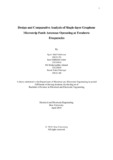| dc.contributor.advisor | Sagor, Md. Hasanuzzaman | |
| dc.contributor.author | Sahdman, Syed Abid | |
| dc.contributor.author | Islam, Kazi Shihabul | |
| dc.contributor.author | Ahmed, SK Shahabuddin | |
| dc.contributor.author | Siddiqui, Samir Sakir | |
| dc.date.accessioned | 2019-05-16T05:43:28Z | |
| dc.date.available | 2019-05-16T05:43:28Z | |
| dc.date.copyright | 2019 | |
| dc.date.issued | 2019-04 | |
| dc.identifier.other | ID 19121153 | |
| dc.identifier.other | ID 15121014 | |
| dc.identifier.other | ID 15121019 | |
| dc.identifier.other | ID 19121149 | |
| dc.identifier.uri | http://hdl.handle.net/10361/12068 | |
| dc.description | This thesis is submitted in partial fulfilment of the requirements for the degree of Bachelor of Science in Electrical and Electronic Engineering, 2019. | en_US |
| dc.description | Cataloged from PDF version of thesis. | |
| dc.description | Includes bibliographical references( pages 103-111). | |
| dc.description.abstract | The solution to the growing demand of higher speed wireless communication is the terahertz (THz) band, which will reduce the shortage of spectrum and capacity limitations of current wireless systems and will open new fields of applications in communication and networking domains. However, the existing wireless systems, comprising of classical copper antennas, are ill-equipped to handle this band of frequencies. Graphene, an allotrope of carbon, is a wonder material that proves to be a fine choice for an antenna material operating at the terahertz region. For our research, we have chosen the microstrip patch antenna to carry out our analyses because of its wide range of applications and ease of fabrication and modifications. Our research focuses on the comparison of antenna performances of three different shapes of the single layer graphene patch, and four substrates with different dielectric constants. The range of the operating frequencies were between 6 to 8THz. We have conducted our simulations on the software Computer Simulation Technology (CST), which is a specialized tool for accurate electro-magnetic simulations. Our goal was to find out the best combination of substrate and patch shape on the microstrip patch antenna that will give excellent performances at the terahertz frequency region. The comparisons have shown that combination of rectangular single-layer graphene patch shape with Teflon as the dielectric substrate provides the best antenna performances among all of them. Our findings will facilitate the researches and works towards finding the best practical solution for the difficulties faced in making terahertz communication possible and will contribute to a better and faster wireless communication system for all. | en_US |
| dc.description.statementofresponsibility | Syed Abid Sahdman | |
| dc.description.statementofresponsibility | Kazi Shihabul Islam | |
| dc.description.statementofresponsibility | SK Shahabuddin Ahmed | |
| dc.description.statementofresponsibility | Samir Sakir Siddiqui | |
| dc.format.extent | 111 pages | |
| dc.language.iso | en | en_US |
| dc.publisher | Brac University | en_US |
| dc.rights | Brac University theses are protected by copyright. They may be viewed from this source for any purpose, but reproduction or distribution in any format is prohibited without written permission. | |
| dc.subject | Graphene Microstrip Patch Antennas | en_US |
| dc.subject | Terahertz frequencies | en_US |
| dc.subject | Single layer graphene patch | en_US |
| dc.subject | Dielectric substrates | en_US |
| dc.subject.lcsh | Microstrip antennas | |
| dc.title | Design and comparative analysis of single-layer Graphene Microstrip patch antennas operating at Terahertz frequencies | en_US |
| dc.type | Thesis | en_US |
| dc.contributor.department | Department of Electrical and Electronic Engineering, Brac University | |
| dc.description.degree | B. Electrical and Electronic Engineering | |

